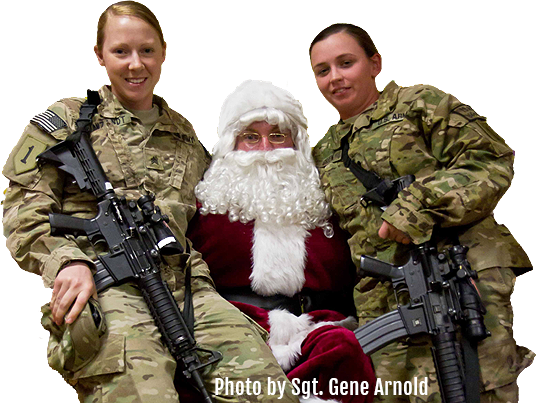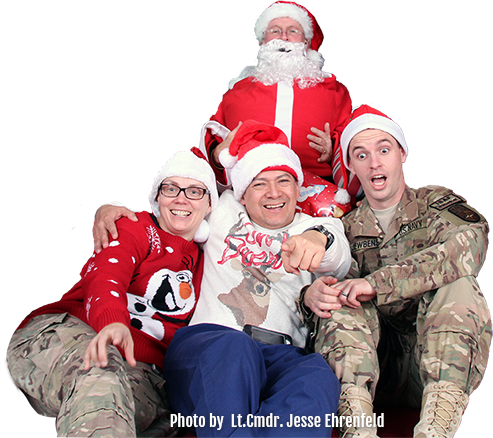Meet Your Military
- Details
- Hits: 4338
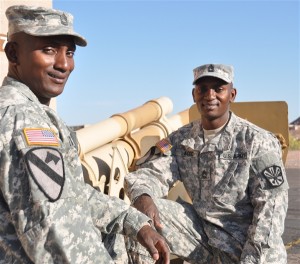 PHOTO: Twin brothers Army Master Sgts. Frederick and Derick Aidoo joined the Arizona National Guard together in 1993 and continue to serve side by side. U.S. Air Force photo by Capt. Matthew Murphy PHOENIX – Twin brothers Derick and Frederick Aidoo recently pinned on the rank of master sergeant here -- literal brothers in arms who serve the state and nation in the Arizona Army National Guard. Their colleagues say they serve with two times the dedication, two times the commitment and two times the honor. Like many twins, the Aidoos have a tendency to finish each other’s sentences. About his service in the Guard, Derick said, “The Army has kept me on track. It keeps life on track with fitness and lifestyle.” Then Frederick said, “It’s a foundation. Something to tell your kids,” and Derick chimed in with, “about being a soldier and proud to tell people who you are.” The brothers are two-time combat veterans, having served in Iraq in 2004 and in Afghanistan 2010.
PHOTO: Twin brothers Army Master Sgts. Frederick and Derick Aidoo joined the Arizona National Guard together in 1993 and continue to serve side by side. U.S. Air Force photo by Capt. Matthew Murphy PHOENIX – Twin brothers Derick and Frederick Aidoo recently pinned on the rank of master sergeant here -- literal brothers in arms who serve the state and nation in the Arizona Army National Guard. Their colleagues say they serve with two times the dedication, two times the commitment and two times the honor. Like many twins, the Aidoos have a tendency to finish each other’s sentences. About his service in the Guard, Derick said, “The Army has kept me on track. It keeps life on track with fitness and lifestyle.” Then Frederick said, “It’s a foundation. Something to tell your kids,” and Derick chimed in with, “about being a soldier and proud to tell people who you are.” The brothers are two-time combat veterans, having served in Iraq in 2004 and in Afghanistan 2010.
While Frederick is an architect in his civilian life and Derick is a construction engineer, their military careers and training are mirrored. Army Chief Warrant Officer Hector Mendoza deployed with the brothers to Afghanistan. Frederick served as Mendoza’s noncommissioned officer in charge. Mendoza had an opportunity to observe the brothers in action. “If one does one thing, so does the other. Their work ethic, their fitness level, their commitment -- it’s exactly the same,” he said. “Frederick worked with me and Derick worked with another chief warrant officer. During the entire deployment, the brothers worked nonstop and refused to take a day off. I really admire them.” Looking back at their 19 years of service, the brothers chuckled over their memories of basic training and advanced individual training. “The drill sergeants didn’t like us too much, because they couldn’t tell us apart and we were in the same group,” Derick said. “So if they told one of us to drop and do pushups, the other had to do them, too.” The Aidoos trained in supply and logistics.
Read more: Meet Your Military: Twins Share National Guard Experience
- Details
- Hits: 3226
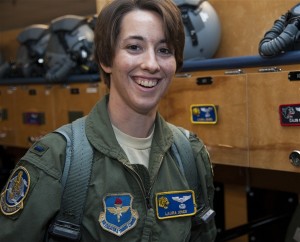 PHOTO: Air Force 1st Lt. Laura Jones poses for a photo after preparing for a flight April 21, 2014, at Laughlin Air Force Base, Texas. Jones was involved in an automobile accident Jan. 2, 2014, that kept her from flying for three months. Jones is a 85th Flying Training Squadron T-6A Texan II instructor pilot. U.S. Air Force photo by Airman 1st Class Jimmie D. PikeLAUGHLIN AIR FORCE BASE, Texas – Her career seemed ruined, her dreams grounded. "At the beginning, I thought I'd never fly again," Air Force 1st Lt. Laura Jones said, recalling her Jan. 2 accident. On her way from San Antonio International Airport back to base, a car next to her had a tire blow out. The driver lost control and swerved into Jones's vehicle traveling at about 75 mph, she said. "Shortly after, a passing National Guardsman arrived, held my neck to immobilize and keep me from damaging my cervical spine and talked to me until the paramedics arrived," said Jones, a T-6 Texan instructor pilot from the 85th Flying Training Squadron. "It all happened pretty quickly -- from getting hit to the helicopter taking me to San Antonio Military Medical Center, only a couple of hours had passed. I maintained consciousness the entire time." Jones suffered broken bones and other injuries during the collision -- injuries that grounded her flying career.
PHOTO: Air Force 1st Lt. Laura Jones poses for a photo after preparing for a flight April 21, 2014, at Laughlin Air Force Base, Texas. Jones was involved in an automobile accident Jan. 2, 2014, that kept her from flying for three months. Jones is a 85th Flying Training Squadron T-6A Texan II instructor pilot. U.S. Air Force photo by Airman 1st Class Jimmie D. PikeLAUGHLIN AIR FORCE BASE, Texas – Her career seemed ruined, her dreams grounded. "At the beginning, I thought I'd never fly again," Air Force 1st Lt. Laura Jones said, recalling her Jan. 2 accident. On her way from San Antonio International Airport back to base, a car next to her had a tire blow out. The driver lost control and swerved into Jones's vehicle traveling at about 75 mph, she said. "Shortly after, a passing National Guardsman arrived, held my neck to immobilize and keep me from damaging my cervical spine and talked to me until the paramedics arrived," said Jones, a T-6 Texan instructor pilot from the 85th Flying Training Squadron. "It all happened pretty quickly -- from getting hit to the helicopter taking me to San Antonio Military Medical Center, only a couple of hours had passed. I maintained consciousness the entire time." Jones suffered broken bones and other injuries during the collision -- injuries that grounded her flying career.
"The accident left me with a shattered left femur, lacerations on my kidney and spleen, my right wrist was broken in four places, my jaw was broken in two places, and my lungs were bruised, among other scrapes," Jones said. "After I heard there were no neck, spine or eye injuries, I knew I would be flying soon enough." The accident was followed by 11 days in the hospital and several grueling months of physical therapy and rehabilitation. "We started her with basic range-of-motion exercises to work up to light weights and ensure she didn't overwork herself," said Kira Pie, a physical therapy assistant. "We now have her going through impact workouts, like skipping, to get her body adjusted to the feel of pressure on the joints and bones." Even though her body was aching and her workouts were strenuous, Jones worked through the difficulties with a single goal: to return to flying.
Read more: Meet Your Military: Pilot Flies Again After Highway Crash
- Details
- Hits: 2274
 PHOTO: Air Force Staff Sgt. Thomas Sherrill, right, stands with Albert Pujols of the Los Angeles Angels of Anaheim after catching Pujols' 500th career major league home run, April 22, 2014, at Nationals Park in WashingtonWASHINGTON – Even before he took his seat at Nationals Park here April 22, Air Force Staff Sgt. Thomas Sherrill said, he fantasized about what he would do if he somehow caught the milestone home run ball off the bat of slugger Albert Pujols. Sherrill, a long-time Angels fan, moved into the left-center-field bleachers of shortly before Pujols' milestone homer. Courtesy photo The Los Angeles Angels of Anaheim first baseman began the game against the Washington Nationals two home runs shy of 500 in his Major League Baseball career. He struck for home run 499 in the top of the first inning. Anticipating Pujols’ next time at bat and seated in foul territory, Sherrill said, he and a friend spotted an opportunity to sit on the fair side of the foul pole, creating an outside chance of being in the area where the potential home run might land. With Pujols down in the count with one ball and two strikes, Sherrill said, he started to feel that it just wasn’t in the cards that night.
PHOTO: Air Force Staff Sgt. Thomas Sherrill, right, stands with Albert Pujols of the Los Angeles Angels of Anaheim after catching Pujols' 500th career major league home run, April 22, 2014, at Nationals Park in WashingtonWASHINGTON – Even before he took his seat at Nationals Park here April 22, Air Force Staff Sgt. Thomas Sherrill said, he fantasized about what he would do if he somehow caught the milestone home run ball off the bat of slugger Albert Pujols. Sherrill, a long-time Angels fan, moved into the left-center-field bleachers of shortly before Pujols' milestone homer. Courtesy photo The Los Angeles Angels of Anaheim first baseman began the game against the Washington Nationals two home runs shy of 500 in his Major League Baseball career. He struck for home run 499 in the top of the first inning. Anticipating Pujols’ next time at bat and seated in foul territory, Sherrill said, he and a friend spotted an opportunity to sit on the fair side of the foul pole, creating an outside chance of being in the area where the potential home run might land. With Pujols down in the count with one ball and two strikes, Sherrill said, he started to feel that it just wasn’t in the cards that night.
The next pitch was a sinker that Pujols took deep to left-center field. “I could tell where it was going,” Sherrill said. “It was well above me, so I just jumped out of my chair and started running up the stairs.” Sherrill said he looked up to see another man running down the steps – the race was on. “I knew it was going to him. … I gave up on the ball at that point,” he said. “But it bounced off him, and I was able to grab it off the hop.” He said he looked down at the ball in his hands, and all at once he realized he had just caught Pujols’ 500th home run. At this point, the decision literally was in his hands: Give the ball back to Pujols, or keep the high-value souvenir for himself. “Even before that day, … I had already decided if I somehow caught it, I would give it back,” Sherrill said. “It just seemed like the right thing to do. When I actually had the ball in my hand, nothing changed. I still felt the same way. It’s his milestone. It’s his ball,” he continued. “Who am I to try to sell it back to him?” As Chris Gordon, the man who missed his chance at catching the home run, shook Sherrill’s hand and congratulated him, Sherrill said, he felt compelled to offer a consolation prize, and arranged for Gordon and his children to accompany him to meet Pujols.
Read more: Meet Your Military: Airman Catches Milestone Homer, Returns It
- Details
- Hits: 3425
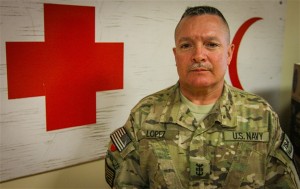 PHOTO: Navy Master Chief Petty Officer Juan Lopez smiles for the camera at the Role 3 NATO Multinational Medical Unit Hospital, Kandahar Airfield, Afghanistan, April 4, 2014. Lopez, serving on his 12th deployment, is the senior enlisted advisor to the hospital’s command group. U.S. Army photo by Cpl. Clay Beyersdorfer KANDAHAR AIRFIELD, Afghanistan – Because he has traveled around the world and served on 11 deployments, some might think Command Master Chief Petty Officer Juan Lopez would be winding down in his Navy career. He says otherwise. “The day I ‘have’ to do something is the day I will leave,” Lopez said. “I don’t see that happening any time soon. I love what I do. I could never get tired of this.” Lopez is serving on his 12th deployment, this time as the command master chief of the Role 3 NATO Multinational Medical Unit Hospital here. As the senior enlisted advisor to the hospital’s command group, Lopez acts as the voice for all enlisted sailors serving there. “Any need they may have, I make sure it gets taken care of,” he said. “I take care of everything that may cause an issue for them. T
PHOTO: Navy Master Chief Petty Officer Juan Lopez smiles for the camera at the Role 3 NATO Multinational Medical Unit Hospital, Kandahar Airfield, Afghanistan, April 4, 2014. Lopez, serving on his 12th deployment, is the senior enlisted advisor to the hospital’s command group. U.S. Army photo by Cpl. Clay Beyersdorfer KANDAHAR AIRFIELD, Afghanistan – Because he has traveled around the world and served on 11 deployments, some might think Command Master Chief Petty Officer Juan Lopez would be winding down in his Navy career. He says otherwise. “The day I ‘have’ to do something is the day I will leave,” Lopez said. “I don’t see that happening any time soon. I love what I do. I could never get tired of this.” Lopez is serving on his 12th deployment, this time as the command master chief of the Role 3 NATO Multinational Medical Unit Hospital here. As the senior enlisted advisor to the hospital’s command group, Lopez acts as the voice for all enlisted sailors serving there. “Any need they may have, I make sure it gets taken care of,” he said. “I take care of everything that may cause an issue for them. T
hat way, they can go focus on their jobs here.” He also oversees the Chief Petty Officer 365 program, which is designed to help chief petty officers advance in their careers and eventually become senior and master chief petty officers. Lopez talked about his motivation to emphasize the CPO 365 program, as well as the importance of being a chief petty officer. “I want someone to eventually take over for me and be able to succeed at this position,” he said. “Once you become a chief, senior chief and master chief, it’s not about you any more.
Read more: Meet Your Military: Navy Master Chief Serves on 12th Deployment
- Details
- Hits: 2948
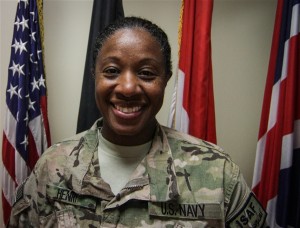 PHOTO: Navy Reserve Petty Officer 2nd Class Charmaine Henry serves as a surgical technologist at Kandahar Airfield, Afghanistan. U.S. Army photo by Cpl. Clay Beyersdorfer KANDAHAR AIRFIELD, Afghanistan – Petty Officer 2nd Class Charmaine Henry is a U.S. Navy reservist, but she has spent a great deal of time serving on active duty tours. In her assignment here, Henry serves as a surgical technologist at the Role 3 NATO Multinational Medical Unit hospital. Her duties include assisting medical officers in carrying out surgical techniques, including selecting, sterilizing and preparing instruments and materials and creating the aseptic environment necessary for surgery. Despite the high-intensity nature of the job, Henry said, she remains cool.
PHOTO: Navy Reserve Petty Officer 2nd Class Charmaine Henry serves as a surgical technologist at Kandahar Airfield, Afghanistan. U.S. Army photo by Cpl. Clay Beyersdorfer KANDAHAR AIRFIELD, Afghanistan – Petty Officer 2nd Class Charmaine Henry is a U.S. Navy reservist, but she has spent a great deal of time serving on active duty tours. In her assignment here, Henry serves as a surgical technologist at the Role 3 NATO Multinational Medical Unit hospital. Her duties include assisting medical officers in carrying out surgical techniques, including selecting, sterilizing and preparing instruments and materials and creating the aseptic environment necessary for surgery. Despite the high-intensity nature of the job, Henry said, she remains cool.
“It’s all systematic when you do it enough. You adjust yourself accordingly,” the Queens, N.Y, native said. “When you do that, everything else tends to fall in place. Basically, you are a mind-reader. You have to pay attention to detail. You have to be a couple of steps ahead of the doctor, know what they are going to do, and what tools they need or what they may need assistance with.” Serving at Role 3 allows Henry to work among members of other service branches, and that’s something she has appreciated, Henry said. “It’s been great because you can pick the brains of other people and talk a little bit about everything,” she explained. “The communication has been great, and I have learned a lot from the other services.”
Read more: Meet Your Military: Reservist Gathers Experience in Overseas Tours




